|
January - August: |
|
ATY - M
Primary coverts are an irregular mix of black
(fresh), brown, and very pale brown (worn)
feathers OR are uniformly black / dark brown
(only marginally paler than wing). Iris deep
red. Crown has a red patch. |
 |
 |
 |
|
ATY - F
Primary coverts are an irregular mix of black
(fresh), brown, and very pale brown (worn)
feathers OR are uniformly black / dark brown
(only marginally paler than wing). Iris deep
red. Crown does not have a red patch, but may
have 1-2 red feathers. |
 |
 |
 |
|
TY - M
Outer few primary coverts replaced (black), all
other retained primary coverts pale brown. Iris
deep red. Crown has a red patch. |
|
 |
|
|
TY - F
Outer few primary coverts replaced (black), all
other retained primary coverts pale brown. Iris
deep red. Crown does not have a red patch, but
may have 1-2 red feathers. |

|
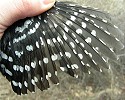
|

|
|
SY - M
Primary coverts uniformly brown and contrast
with the rest of the wing. Crown has a red
patch. |
 |
 |
 |
|
SY - F
Primary coverts uniformly brown and contrast
with the rest of the wing. Crown does not have
a red patch. |
 |
|
|
|
|
September - December: |
|
ASY - M
All primary coverts are replaced (black) OR
there are two generations present with a mixed
pattern. Iris deep red. Crown has a red patch.
|
 |
 |
 |
|
ASY - F
All primary coverts are replaced (black) OR
there are two generations present with a mixed
pattern. Iris deep red. Crown does not have a
red patch, but may have 1-2 red feathers. |

|

|
|
|
SY - M
Outer few primary coverts replaced (black), all
other retained primary coverts brown. Crown has
a red patch. |

|

|

|
|
SY - F
Outer few primary coverts replaced (black), all
other retained primary coverts brown. Crown
does not have a red patch. |
|
|
|
|
HY - M
Primary coverts paler brown than the rest of the
wing. Iris gray/brown. Crown has a red patch. |
 |
 |
 |
|
HY - F
Primary coverts paler brown than the rest of the
wing. Iris gray/brown. Crown does not have a
red patch. |
 |
 |
 |
JUV - U
Primary |
 |
 |
 |
|
Ageing and sexing details:
The crown has a red patch, and the iris is a deep red. It is
occasionally possible to age an ATY with isolated retained juvenal
feathers or 3 generations of primary coverts as a 4Y bird.
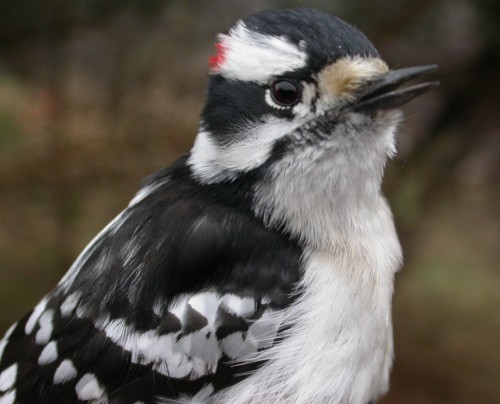
Photo by Marcel Gahbauer, April 2006
Primary coverts are an
irregular mix of black (fresh), brown, and very pale brown (worn)
feathers OR are uniformly black / dark brown (only marginally paler than
wing). The photo below illustrates the latter scenario. Note
the contrast between the fresher black coverts with "full" white spots
along the edge, and the somewhat paler one where the white spot appears
"chewed out" (white abrades more rapidly); this may sometimes be easier
to notice than the difference between dark brown and black feathers.
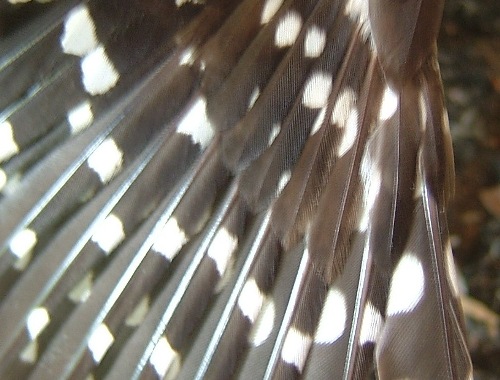
Photo
by Peter Pyle, Howell Woods (NC), May 2006

Photo
by Peter Pyle, Big Sur Ornithology Lab (CA), May 2007

Photo
by Marcel Gahbauer, April 2006
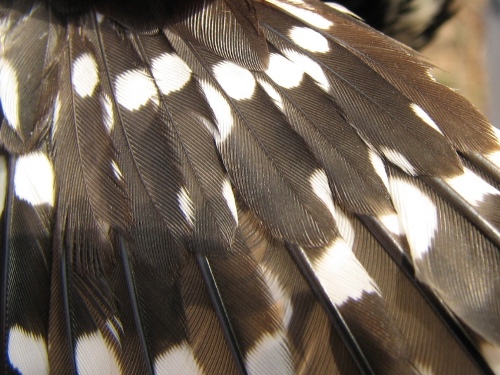
Photo
by Barbara Frei, McGill Bird Observatory (QC), April 2008
Tails are
not terribly useful for ageing or sexing woodpeckers, though can help
differentiate between Downy and Hairy Woodpeckers. The Downy Woodpecker
has black in the outer rectrix while the Hairy rarely does.

Photo
by Marcel Gahbauer, April 2006
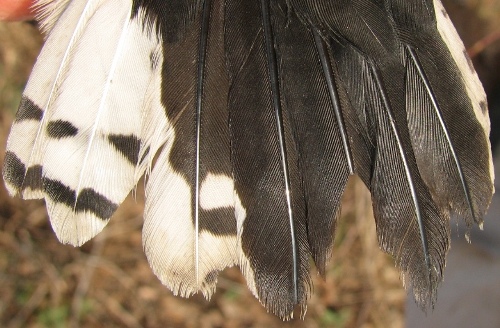
Photo
by Barbara Frei, McGill Bird Observatory (QC), April 2008
RETURN TO AGE/SEX OVERVIEW
The crown does not have a red patch, but may have 1-2 red
feathers, and the iris is a deep red. It is occasionally possible to
age an ATY with isolated retained juvenal feathers or 3 generations of
primary coverts as a 4Y bird.
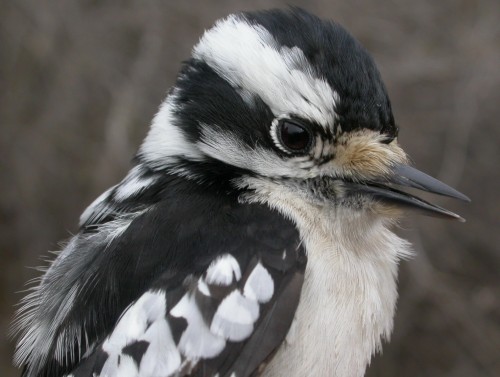
Photo
by Marcel Gahbauer, April 2006
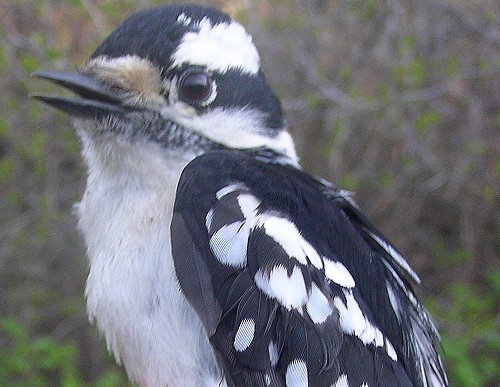
Photo
by Marie-Anne Hudson, April 2007
Primary coverts are an
irregular mix of black (fresh), brown, and very pale brown (worn)
feathers OR are uniformly black / dark brown (only marginally paler than
wing). The latter scenario is illustrated by the second photo below, with
a somewhat paler covert contrasting visibly with black coverts on either
side of it. Note also that the white spot on the older covert is
considerably more abraded than on the newer feathers; depending on light
conditions this may be easier to see than the difference between dark
brown and black.
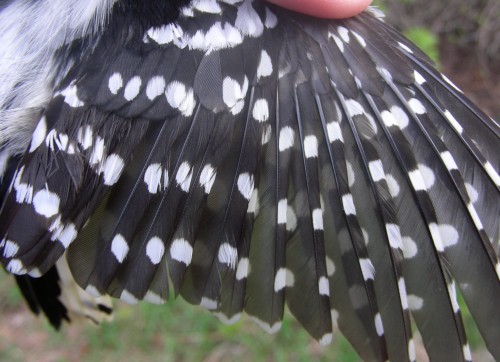
Photo
by Marie-Anne Hudson, April 2007
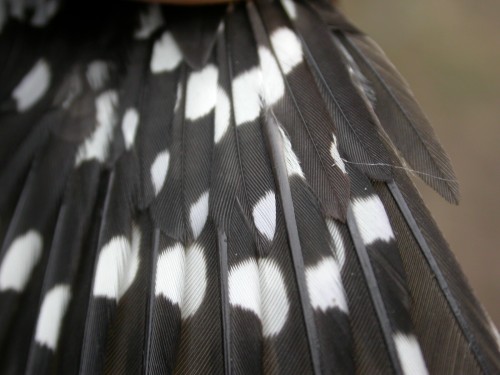
Photo
by Marcel Gahbauer, April 2006
Tails are
not terribly useful for ageing or sexing woodpeckers, though can help
differentiate between Downy and Hairy Woodpeckers. The Downy Woodpecker
has black in the outer rectrix while the Hairy rarely does.
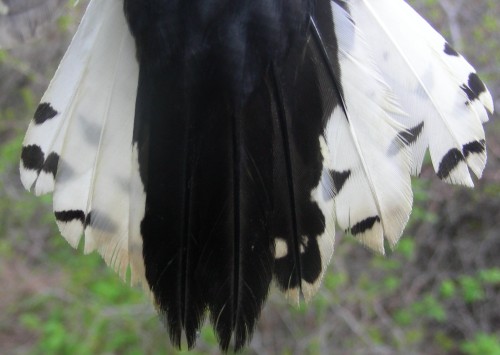
Photo
by Marie-Anne Hudson, April 2007
RETURN TO AGE/SEX OVERVIEW
Crown has a red patch.
The outer few primary coverts are replaced (black). All other
retained primary coverts are pale brown. It is possible that a few
extremely faded juvenal secondaries may be retained (s1-s5). Some
intermediates may occur that are extremely difficult to age. These
should be aged ASY.
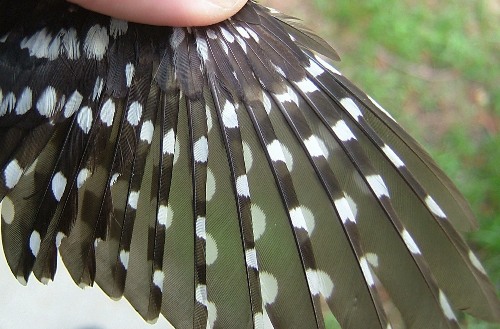
Photo
by Peter Pyle, Howell Woods (NC), May 2006
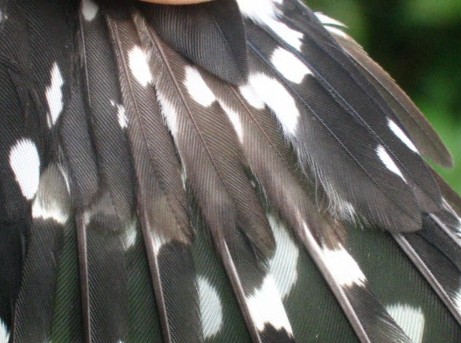
Photo
by Seabrooke Leckie, August 2006
Tails are
not terribly useful for ageing or sexing woodpeckers, though can help
differentiate between Downy and Hairy Woodpeckers. The Downy Woodpecker
has black in the outer rectrix while the Hairy rarely does.
RETURN TO AGE/SEX OVERVIEW
Crown does not have a red patch, but may have 1-2 red
feathers.
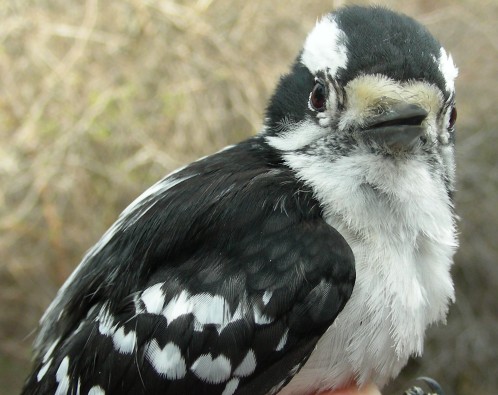
Photo
by Marie-Anne Hudson, McGill Bird Observatory (QC), April 2008
The outer few primary coverts are replaced (black). All other
retained primary coverts are pale brown. It is possible that a few
extremely faded juvenal secondaries may be retained (s1-s5). Some
intermediates may occur that are extremely difficult to age. These
should be aged ASY.
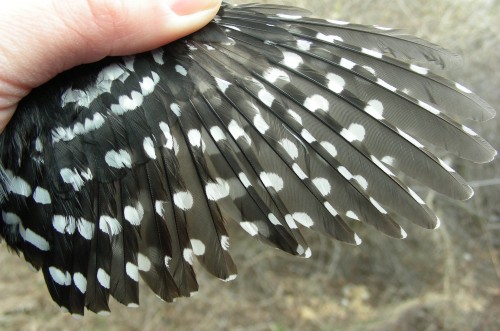
Photo
by Marie-Anne Hudson, McGill Bird Observatory (QC), April 2008
Tails are
not terribly useful for ageing or sexing woodpeckers, though can help
differentiate between Downy and Hairy Woodpeckers. The Downy Woodpecker
has black in the outer rectrix while the Hairy rarely does.
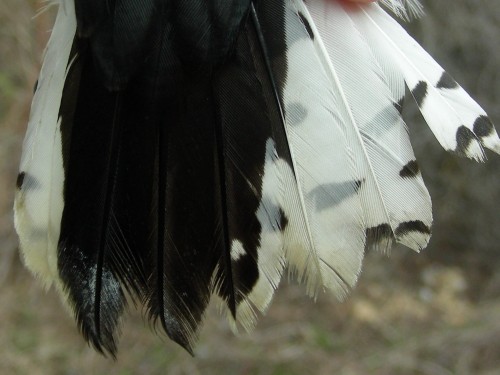
Photo
by Marie-Anne Hudson, McGill Bird Observatory (QC), April 2008
RETURN TO AGE/SEX OVERVIEW
Crown has a red patch, and the iris is usually gray-brown.
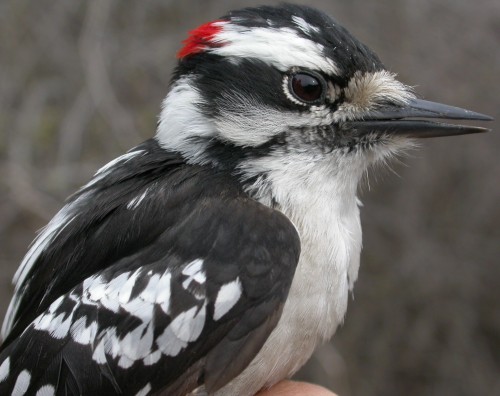
Photo
by Marcel Gahbauer, April 2006
Primary coverts uniformly worn and brown and contrast
with the rest of the wing. Look for retention of juvenal
characteristics: a larger, rounded p10.
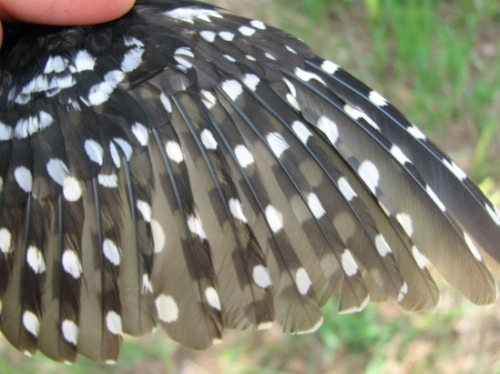
Photo
by Barbara Frei, McGill Bird Observatory (QC), May 2007
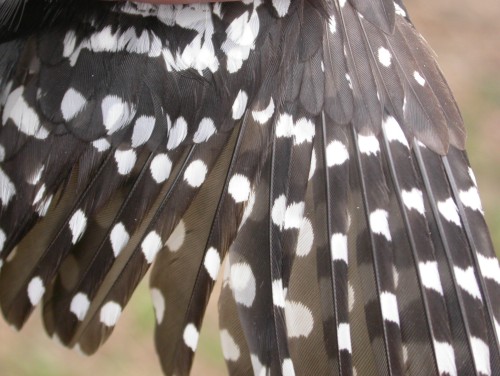
Photo
by Marcel Gahbauer, April 2006
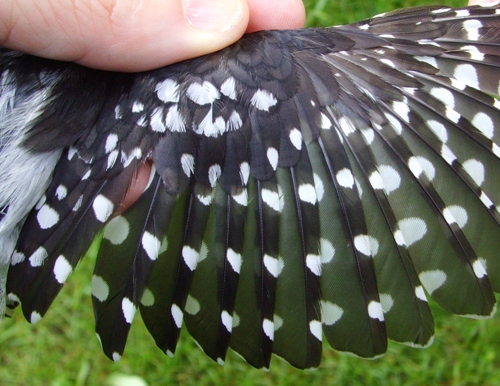
Photo
by Peter Pyle, MerryLea (IN), May 2007
Tails are
not terribly useful for ageing or sexing woodpeckers, though can help
differentiate between Downy and Hairy Woodpeckers. The Downy Woodpecker
has black in the outer rectrix while the Hairy rarely does. However, SY birds can sometimes have
very pointed rectrices that may support other plumage characteristics.
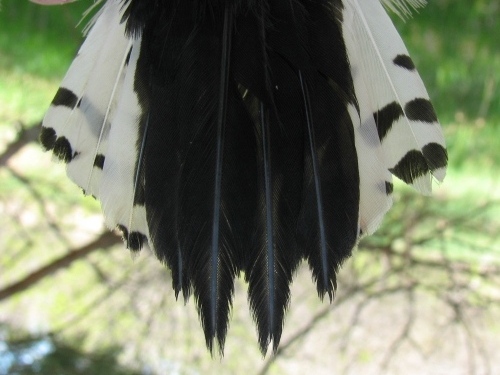
Photo
by Barbara Frei, McGill Bird Observatory (QC), May 2007
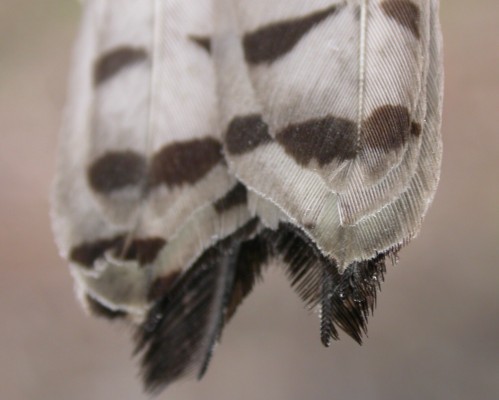
Photo
by Marcel Gahbauer, McGill Bird Observatory (QC), May 2005
RETURN TO AGE/SEX OVERVIEW
Crown does not have a red patch, and the iris is usually
gray-brown.
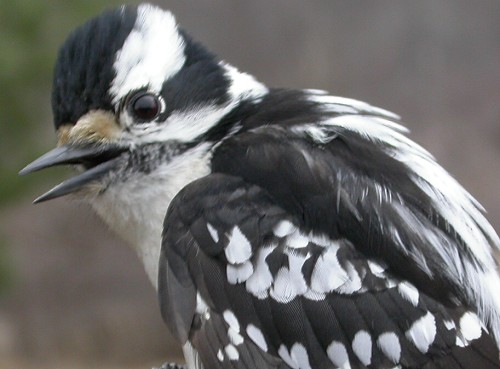
Photo
by Marcel Gahbauer, May 2005
Primary coverts uniformly worn and brown and contrast
with the rest of the wing. Look for retention of juvenal
characteristics: a larger, rounded p10.
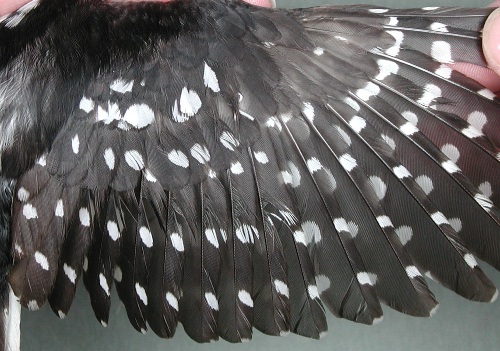
Photo
by Peter Pyle, Big Sur Ornithology Lab (CA), May 2007
Tails are
not terribly useful for ageing or sexing woodpeckers, though can help
differentiate between Downy and Hairy Woodpeckers. The Downy Woodpecker
has black in the outer rectrix while the Hairy rarely does. However, SY birds can sometimes have very
pointed rectrices that may support other plumage characteristics.
RETURN TO AGE/SEX OVERVIEW
The crown has a red patch, and the iris is a deep red. It is
occasionally possible to age an ASY with isolated retained juvenal
feathers or 3 generations of primary coverts as a TY bird.
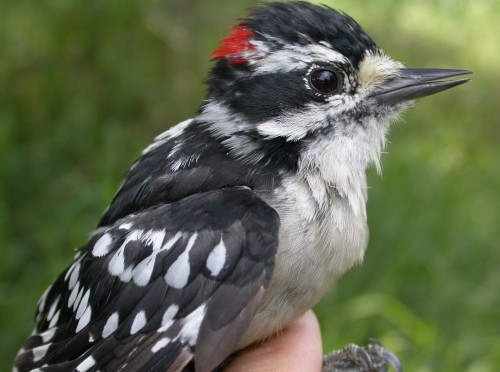
Photo
by Marcel Gahbauer, August 2005
Primary coverts are an irregular mix of black (fresh), brown,
and very pale brown (worn) feathers OR are uniformly black / dark brown
(only marginally paler than wing). The secondaries can either be
uniformly adult with fresh tertials, OR a few older feathers may be
retained, often asymmetrically. ASYs with isolated, retained juvenal
primary coverts or with 3 generations of coverts sequentially replaced
may be aged as TY, but more study is needed.
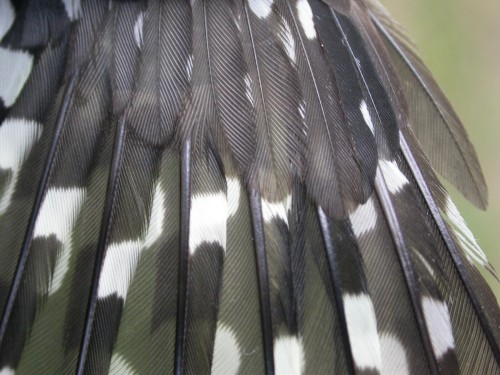
Photo
by Marcel Gahbauer, August 2005
Tails are
not terribly useful for ageing or sexing woodpeckers, though can help
differentiate between Downy and Hairy Woodpeckers. The Downy Woodpecker
has black in the outer rectrix while the Hairy rarely does.
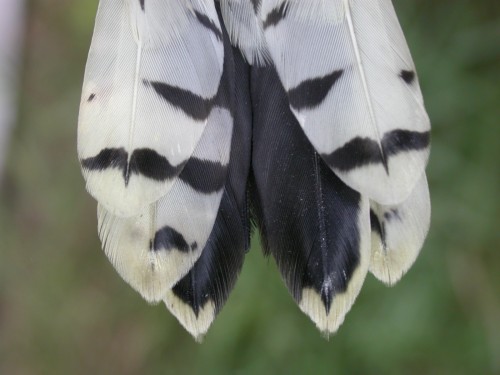
Photo
by Marcel Gahbauer, August 2005
RETURN TO AGE/SEX OVERVIEW
The crown does not have a red patch, but may have 1-2 red
feathers, and the iris is a deep red. It is occasionally possible to
age an ASY with isolated retained juvenal feathers or 3 generations of
primary coverts as a TY bird.
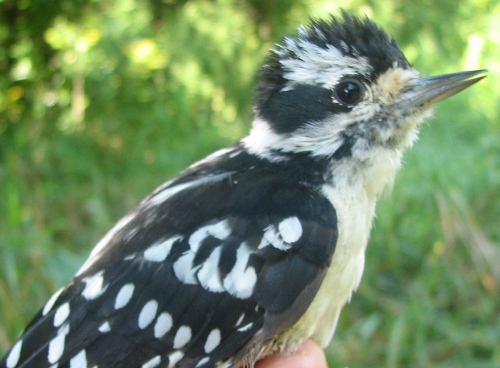
Photo
by Barbara Frei, McGill Bird Observatory (QC), August 2007
Primary coverts are an irregular mix of black (fresh), brown,
and very pale brown (worn) feathers OR are uniformly black / dark brown
(only marginally paler than wing). The secondaries can either be
uniformly adult with fresh tertials, OR a few older feathers may be
retained, often asymmetrically. ASYs with isolated, retained juvenal
primary coverts or with 3 generations of coverts sequentially replaced
may be aged as TY, but more study is needed.
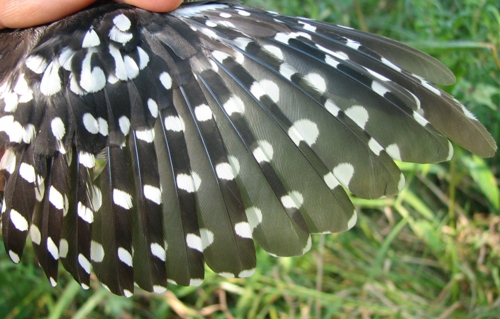
Photo
by Barbara Frei, McGill Bird Observatory (QC), August 2007

Photo
by Barbara Frei, McGill Bird Observatory (QC), August 2007
Tails are
not terribly useful for ageing or sexing woodpeckers, though can help
differentiate between Downy and Hairy Woodpeckers. The Downy Woodpecker
has black in the outer rectrix while the Hairy rarely does.
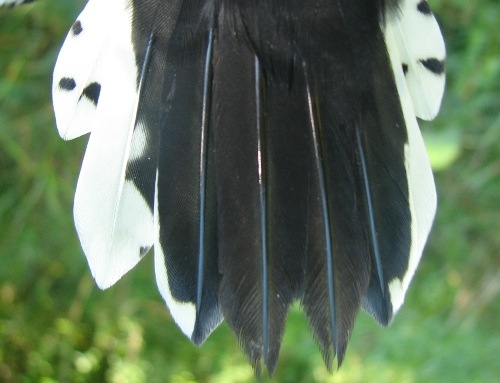
Photo
by Barbara Frei, McGill Bird Observatory (QC), August 2007
RETURN TO AGE/SEX OVERVIEW
Crown has a red patch.
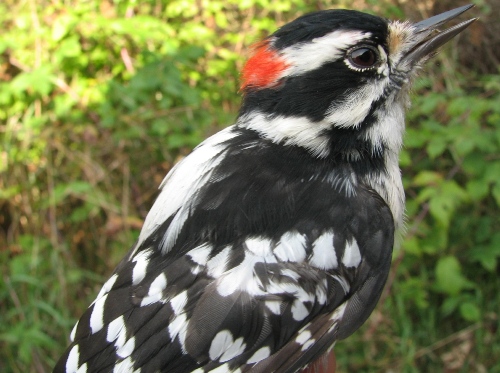
Photo
by Barbara Frei, McGill Bird Observatory (QC), October 2007
Outer few primary coverts replaced (black), all other
retained primary coverts brown. The secondaries are either uniformly
adult with fresh tertials OR may contain 1-4 retained juvenal feathers.
These should be symmetrical in both wings, faded, abraded and
contrasting markedly with the fresher, replaced feathers. Some
intermediates are difficult to separate from ASY and should be aged as
AHY.
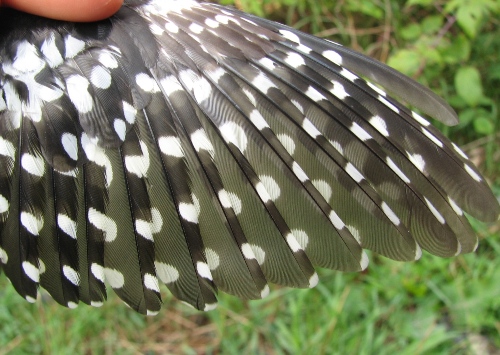
Photo
by Barbara Frei, McGill Bird Observatory (QC), October 2007
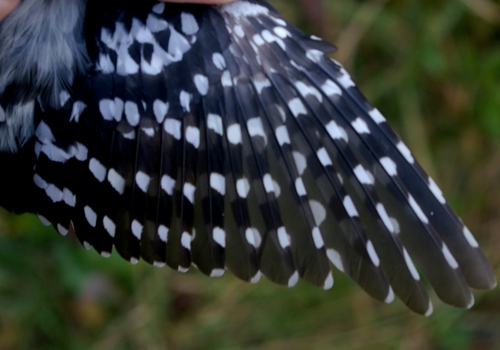
Photo
by James Junda, McGill Bird Observatory (QC), October 2008

Photo
by James Junda, McGill Bird Observatory (QC), October 2008
Tails are
not terribly useful for ageing or sexing woodpeckers, though can help
differentiate between Downy and Hairy Woodpeckers. The Downy Woodpecker
has black in the outer rectrix while the Hairy rarely does.
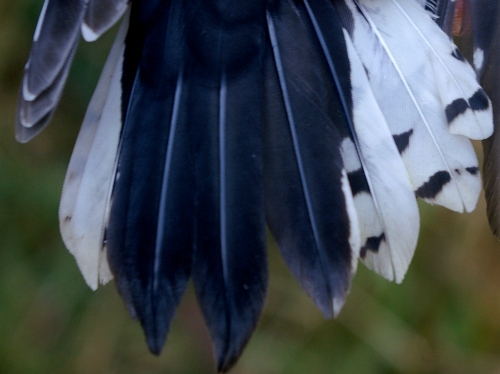
Photo
by James Junda, McGill Bird Observatory (QC), October 2007
RETURN TO AGE/SEX OVERVIEW
Crown does not have a red patch.
Outer few primary coverts replaced (black), all other
retained primary coverts brown. The secondaries are either uniformly
adult with fresh tertials OR may contain 1-4 retained juvenal feathers.
These should be symmetrical in both wings, faded, abraded and
contrasting markedly with the fresher, replaced feathers. Some
intermediates are difficult to separate from ASY and should be aged as
AHY.
Tails are
not terribly useful for ageing or sexing woodpeckers, though can help
differentiate between Downy and Hairy Woodpeckers. The Downy Woodpecker
has black in the outer rectrix while the Hairy rarely does.
RETURN TO AGE/SEX OVERVIEW
Crown has a red patch, and the iris is gray/brown.
On juveniles (as in the third photo below), the red may extend forward
on the crown.
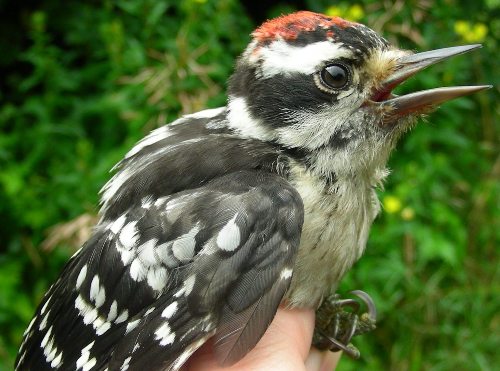
Photo
by Marie-Anne Hudson, McGill Bird Observatory (QC), August 2008
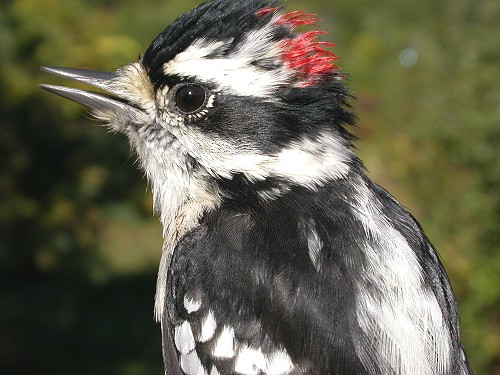
Photo by
Marcel Gahbauer, October 2004
Primary coverts are paler brown than the rest of the
wing. Caution: fresh fall HYs can resemble ASYs with uniform
secondaries and primary coverts. Look for retention of juvenal
characteristics through October: a larger, rounded p10.
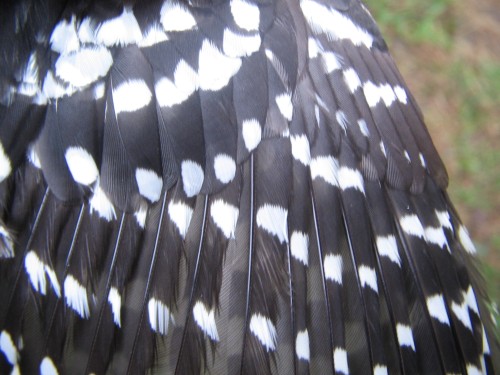
Photo
by Marcel Gahbauer, October 2005
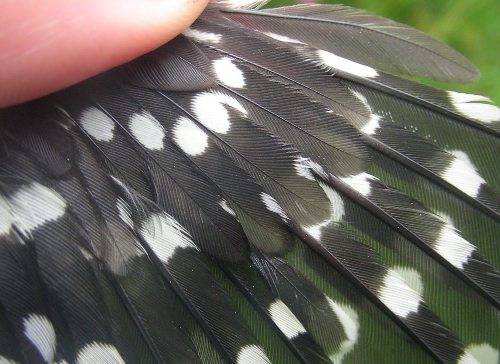
Photo
by Marie-Anne Hudson, McGill Bird Observatory (QC), August 2008
Tails are
not terribly useful for ageing or sexing woodpeckers, though can help
differentiate between Downy and Hairy Woodpeckers. The Downy Woodpecker
has black in the outer rectrix while the Hairy rarely does. However, HY birds can sometimes have very
pointed rectrices that may support other plumage characteristics.
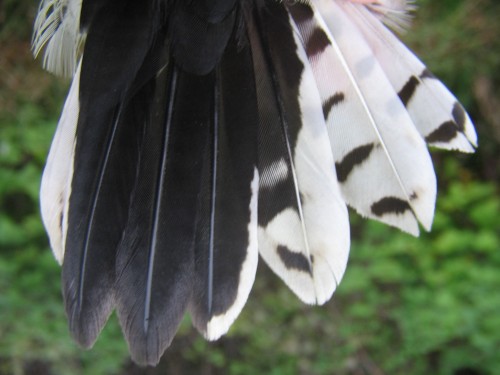
Photo
by Marcel Gahbauer, October 2005
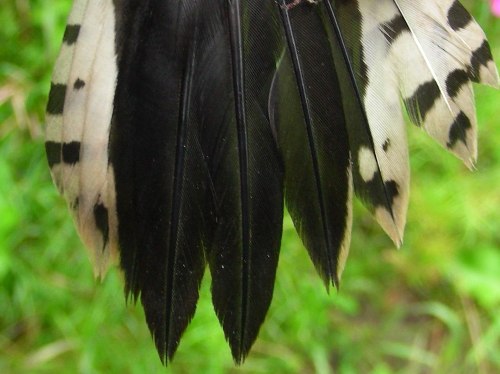
Photo
by Marie-Anne Hudson, McGill Bird Observatory (QC), August 2008
RETURN TO AGE/SEX OVERVIEW
Crown does not have a red patch, and the iris is gray/brown.
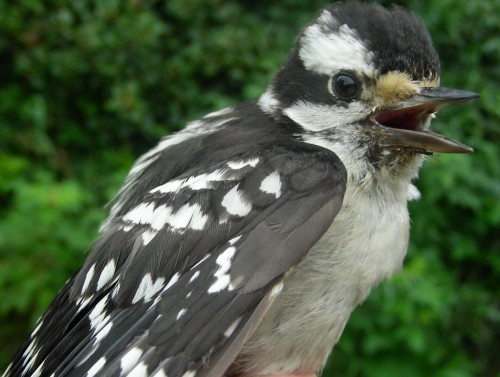
Photo
by Marie-Anne Hudson, August 2007
Primary coverts are paler brown than the rest of the
wing. Caution: fresh fall HYs can resemble ASYs with uniform
secondaries and primary coverts. Look for retention of juvenal
characteristics through October: a larger, rounded p10.
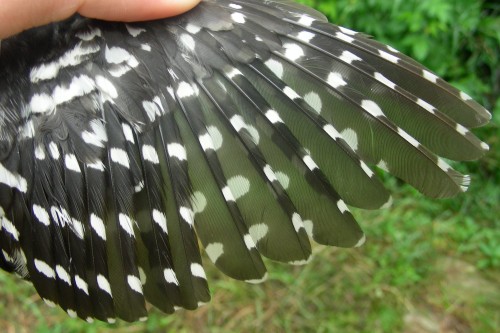
Photo
by Marie-Anne Hudson, August 2007
Tails are
not terribly useful for ageing or sexing woodpeckers, though can help
differentiate between Downy and Hairy Woodpeckers. The Downy Woodpecker
has black in the outer rectrix while the Hairy rarely does. However, HY birds can sometimes have
very pointed rectrices that may support other plumage characteristics.
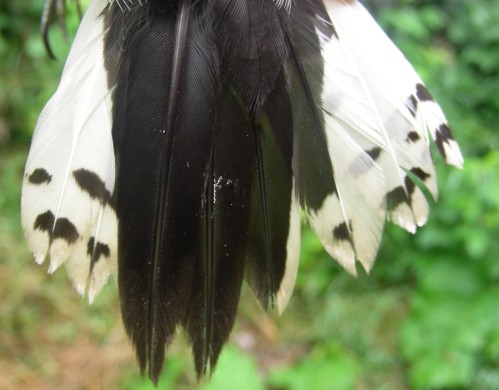
Photo
by Marie-Anne Hudson, August 2007
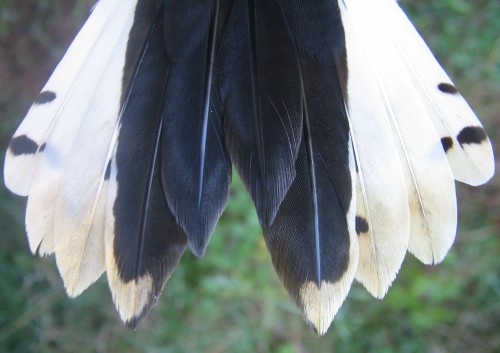
Photo
by Marcel Gahbauer, August 2005
Crown does not have a red patch, and the iris is gray/brown.
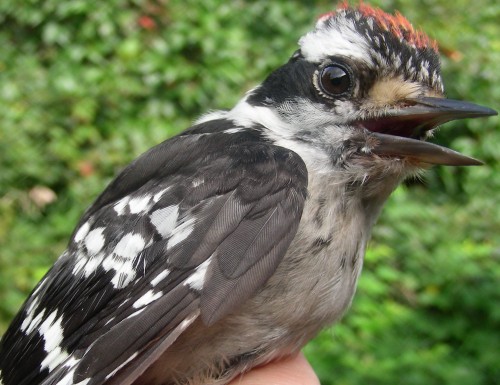
Photo
by Marie-Anne Hudson, August 2007

Photo
by Marcel Gahbauer, August 2007
Primary coverts are paler brown than the rest of the
wing. Caution: fresh fall HYs can resemble ASYs with uniform
secondaries and primary coverts. Look for retention of juvenal
characteristics through October: a larger, rounded p10.
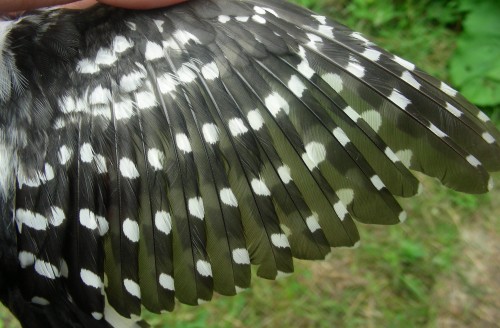
Photo
by Marie-Anne Hudson, August 2007
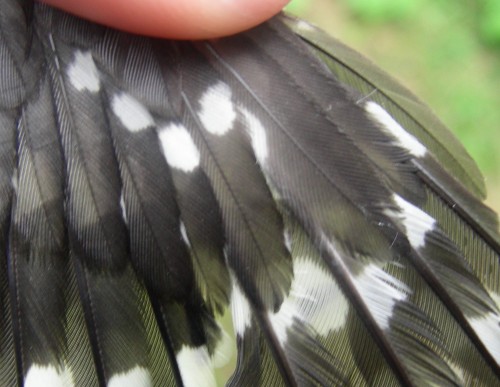
Photo
by Marie-Anne Hudson, August 2007
Tails are
not terribly useful for ageing or sexing woodpeckers, though can help
differentiate between Downy and Hairy Woodpeckers. The Downy Woodpecker
has black in the outer rectrix while the Hairy rarely does. However, HY birds can sometimes have
very pointed rectrices that may support other plumage characteristics.

Photo
by Marcel Gahbauer, August 2005
RETURN
TO AGE/SEX OVERVIEW